Today, in this blog post we are going to discuss the different types of beam and their classification based on end supports, the shape of the cross-section, type of material, geometry, equilibrium condition, and many others. Before diving towards the different types of beam, we must be familiar with the term beam. What does it mean? So, let’s start.
Define the term beam.
The beam is a kind of structural member. Its main purpose is to transfer the loads produced on its axis to its different supportive units like
columns, walls, etc.
Now, let’s talk about the different types of beam and their classification.
What are the different types of beams?
The different types of beam and their classification based on end supports, the shape of the cross-section, type of material, geometry, equilibrium condition, and many others are enlisted below:
According to end supports condition
- Simply supported beam
- Cantilever beam
- Continuous beam
- Fixed end beam
- Overhanging beam
- Double overhanging beam
According to the type of material
- Concrete beam
- Steel beam
- Timber beam
According to the geometry
- Straight beam
- Curved beam
- Tapered beam
According to the casting condition
- In-situ casting
- Precast concrete beam
- Prestressed concrete beam
According to the shape of the cross-section
- Rectangular Beam
- I- beam
- T- beam
- C- Beam
According to the equilibrium condition
- Statically determinate beam
- Statically indeterminate beam
Also Read: Types Of Foundation & Their Uses In Building Construction
According to end supports condition
1. Simply Supported Beam
It is a kind of beam supported at two ends. It consists of pin support at one end and a roller support at the other end.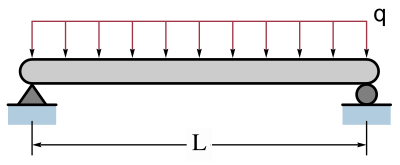 It is the simplest structural element. Its ends willingly rest on different structural elements like walls or columns or stick edges. In all those above-mentioned cases, the reaction goes upwards.
It is the simplest structural element. Its ends willingly rest on different structural elements like walls or columns or stick edges. In all those above-mentioned cases, the reaction goes upwards.
2. Cantilever Beam
It is a kind of beam whose one end is fixed and the other end is left free. In other words, it’s one end is anchored.
This type of beam transmits the load to the support where it is pushed against by the moment and shear stress acting on it. Cantilevers can also be designed with trusses or slabs.
Some of the examples of cantilever beams are the corridors in a building, highway directional signs, swimming pool diving boards, and many more.
3. Continuous Beam
It is a kind of beam that consists of more than two different types of supports. The supports placed at both the ends of the beams are called end supports and the supports placed between the end supports are known as intermediate supports.
4. Fixed End Beam
This type of beam is fixed at both ends and supported by different structural elements like walls and columns which restrains it from rolling or moving horizontally or vertically at any end. 
5. Overhanging Beam
This type of beam is one in which the supports are not placed at the ends i.e. supports are placed beyond the ends. It possesses the properties of both a simply supported beam and a cantilever beam.
6. Double Overhanging Beam
The overhanging part can be placed at one end or at both ends of the beam which is known as a double overhanging beam.
According to the type of material
1. Concrete Beam
Reinforced concrete beams are the important structural members of the buildings which are constructed to hold up the transverse external loads. This carries bending moment, shear forces, and in some examples torsion across their length.
2. Steel Beam
Steel Beams are produced from the molten steel formed into molds and rolled out in different shapes like Beams. Steel beams are very tough, solid, and high stability material in comparison to other building materials.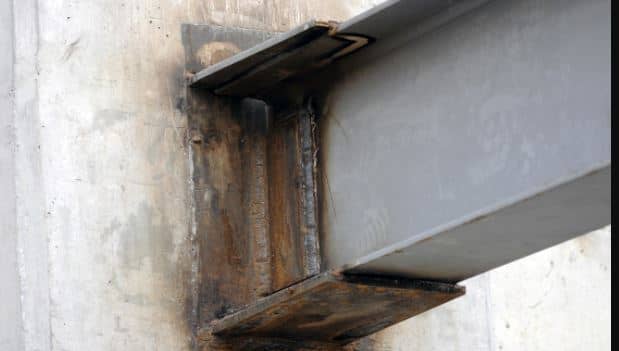
Steel beams are utilized in various types of structures like building, workshops, steel roof trusses, bridges, etc.
3. Timber Beam
The timber beam is mostly utilized in the wooden roof truss structure. The timber beam pushes horizontally between two locales on both sides of the wooden truss.
According to the geometry
1. Straight Beam
This kind of beam is supported at two ends and also carries shearing force and bending moments.
2. Curved Beam
This kind of beam is supported at two ends and also carries shearing force, torsional force, and bending moments.
3. Tapered Beam
It is the same as a straight beam but the cross-sectional area of one end of the beam will be bigger than the other end. It is similar to I-beam.
Also Read: 11 Steps in Construction of Multi Storey Buildings
According to the casting condition
- In-situ casting
- Precast concrete beam
- Prestressed concrete beam
1. In-situ Casting
These are those kinds of beams that are cast in-site and cured. For the process of casting the beam, form-work is cured in the definite size, and the fresh concrete is spattered in the forms, the compression is done with the vibratory equipment.
2. Precast concrete beam
The Precast beams are cast or built in a plant and far away from the building in a very restrained atmosphere, and favorable conditions are rendered to castings to ascertain the ultimate strength of the beam.
3. Prestressed Concrete Beam
As its name signifies they are prestressed before the process of casting of the beam. Concrete beam structure is arranged with tension wire in it and hydraulic jacks are employed to provide pretension before the process of casting.
According to the shape of the cross-section
1. Rectangular Beams
The rectangular beams have a cross-section rectangular shape. These kinds of beams commonly encounter tension at the bottom and compression at the top.
Rectangular beams are the most popular types of beams utilized in constructing buildings.
2. I-Beam
I – Beam is shaped like an alphabet “I”. Also, it is a structural element in the form of an “I”, implying a central tangle with a crossbar at the top and bottom.
3. T-Beam
The beam is constructed in the shape of a “T” cross-section. This beam is normally shaped with the slab. As a result, the slab works as an essential part of the beam and twists in the longitudinal direction of the beam.
4. L-Beam
L – Beam placed at the corner or around the perimeter of the slab. Also, we can determine the end beams including slabs only on one side.
According to the equilibrium condition
1. Statically Determinate Beams
You must find that cantilevers, simply supported beams, and overhanging beams are known as Statically Determinate Beams. Because the reactions of these beams at their end supports can be assumed by the rule of equations of static equilibrium and the reactions are free of the deformation of beams.
2. Statically Indeterminate Beams
The fixed beams and continuous beams are inferred as Statically Indeterminate Beams because their reactions cannot be assumed by the rule of equations of static equilibrium.
Also Read: Grading of Aggregates by Using Different Methods
Frequently Asked Questions
-
What are the different types of supports?
There are five different types of supports enlisted below:
• Roller supports
• Pinned support
• Fixed support
• Hanger support
• Simple support -
What are the purposes of the beam rules?
The main purpose of the beams are as follows:-
• Contradict bending moment and shear forces.
• Unite the building together.
• Provide a uniform distribution of loads. -
What is a simple beam?
It is a kind of beam supported at two ends. It consists of pin support at one end and a roller support at the other end.
It is the simplest structural element. Its ends willingly rest on different structural elements like walls or columns or stick edges. In all those above-mentioned cases, the reaction goes upwards.
-
What are the different types of beams?
The different types of beam and their classification based on end supports, the shape of the cross-section, type of material, geometry, equilibrium condition, and many others are enlisted below:
According to end supports condition
• Simply supported beam
• Cantilever beam
• Continuous beam
• Fixed end beam
• Overhanging beam
• Double overhanging beamAccording to the type of material
• Concrete beam
• Steel beam
• Timber beamAccording to the geometry
• Straight beam
• Curved beam
• Tapered beamAccording to the casting condition
• In-situ casting
• Precast concrete beam
• Prestressed concrete beamAccording to the shape of the cross-section
• Rectangular Beam
• I- beam
• T- beam
• C- BeamAccording to the equilibrium condition
• Statically determinate beam
• Statically indeterminate beam -
What are the different types of loads acting on a beam
Here are the various types of loads acting on beams:
• Point load or concentrated load.
• Uniformly distributed load.
• Uniformly varying load.
Conclusion
Today we have talked about different types of beam and their classification. If you have any questions considering this article feel free to ask by commenting below. If you prefer this article, please don’t forget to share it on social media.


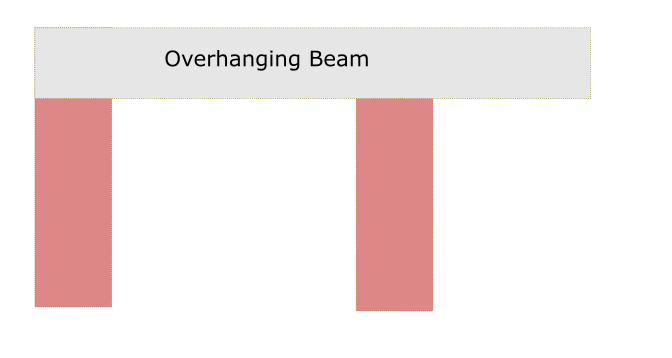
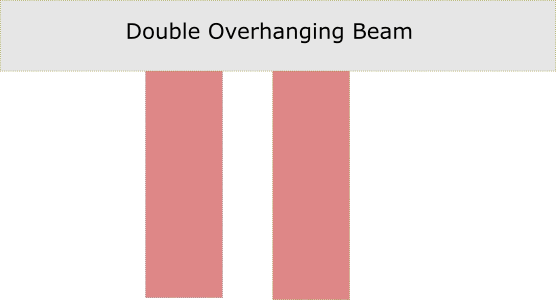
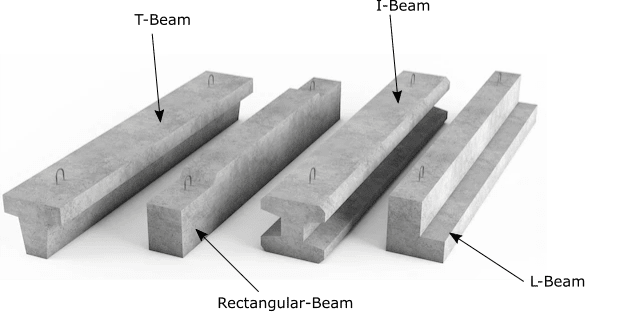
Leave a comment